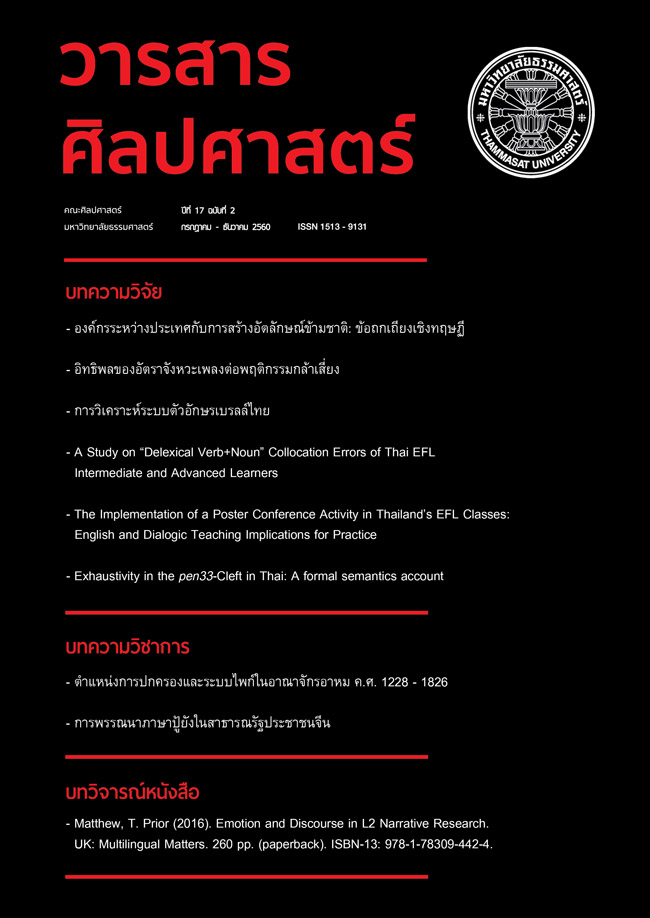การวิเคราะห์ความหมายหมดจดในโครงสร้างประโยคเคล็ฟต์ที่ประกอบด้วยคำว่า "เป็น" ในภาษาไทย โดยวิธีทางอรรถศาสตร์แนวทฤษฎี
Main Article Content
บทคัดย่อ
งานวิจัยชิ้นนี้นำเสนอการวิเคราะห์ความหมายหมดจด (exhaustivity) ในโครงสร้างประโยคเคล็ฟต์ที่ประกอบด้วยคำว่า “เป็น” ในภาษาไทยตามแนวทางการวิเคราะห์ทางอรรถศาสตร์เชิงทฤษฎี ผลการวิเคราะห์พบว่า ความหมายหมดจดที่ปรากฏในโครงสร้างดังกล่าวไม่ได้เป็นส่วนหนึ่งของเงื่อนไขความเป็นจริง (truth conditions) นอกจากนั้น จากการประยุกต์แนวทางการวิเคราะห์ความหมายหมดจดที่อิงความสัมพันธ์ parthood relation ของบิวริงและคริช (2013) พบว่า argument ที่ถูกเน้นในโครงสร้างเคล็ฟต์ที่ประกอบด้วยคำว่า “เป็น” นั้น ไม่ถือเป็น proper part ของ argument ทั้งหมดที่มีลักษณะตามที่บ่งชี้ในประโยคย่อย
Downloads
Article Details

This work is licensed under a Creative Commons Attribution-NonCommercial-NoDerivatives 4.0 International License.
References
Atlas, J. & Levinson, S. (1981). It-clefts, informativeness and logical form: radical pragmatics (revised standard version). Radical pragmatics, 1-62. Academic Press.
Bolinger, D. (1972). A look at equations and cleft sentences. In E. Firchow (Ed.),Studies for Einar Haugen (pp. 96-114). The Hague: Mouton.
Büring, D., & Kriz, M. (2013). It’s that, and that’s it! Exhaustivity and homogeneity presuppositions in clefts (and definites). Semantics and Pragmatics, 6(6), 1-29.
Büring, D. (2011). Conditional exhaustivity presuppositions in clefts (and definites). Unpublished manuscript.
Coppock, E. & Beaver, D. (2011). Sole sisters. Semantics and Linguistic Theory (SALT), 21, 197–217.
Destruel, E. (2012). The French c’est-cleft: An empirical study on its meaning and use. Empirical issues in Syntax and Semantics, 9, 95-112.
Drenhaus, H., Zimmermann, M., & Vasishth, S. (2011). Exhaustiveness effects in clefts are not truth-functional. Journal of Neurolinguistics, 24(3), 320-337.
Gabriel, C. (2010). On focus, prosody and word-order in Argentinian Spanish: A minimalist OT account. ReVEL, 4, 183-222.
Groenendijk, J., & Stokhof, M. (1984). Studies in the semantics of questions and the pragmatics of answers. University of Amsterdam PhD thesis.
Halvorsen, P. (1978). The syntax and semantics of cleft constructions. Texas Linguistics Forum, 11. Austin: University of Texas Department of Linguistics.
Horn, L. (1981). Exhaustiveness and the semantics of clefts. North Eastern Linguistic Society, 14, 108-31.
Kuno, S., & Wongkhomthong, P. (1981). Characterizational and identificational sentences in Thai. Studies in Language, 5, 65-109.
Onea, E. (2009). Exhaustiveness of Hungarian focus: Experimental evidence from Hungarian and German. In A. Riester & E. Onea (Eds.), Proceedings of focus at the syntax-semantics interface. Publikationen des SFB 732, Stuttgart.
Onea, E. & Beaver, D. (2011). Hungarian focus is not exhausted. In E. Cormany, S. Ito & D. Lutz (Eds.), Semantics and Linguistic Theory (SALT), 19, 342-359.
Rooth, M. (1985). Association with focus. Amherst, MA: University of Massachusetts PhD thesis.
Ruangjaroon, S. (2007). Thai Wh-Expressions at the Left Edge of the Clause: Contrastive and Identificational Wh-Clefts. Concentric: Studies in Linguistics, 33(2), 121-157.
von Stechow, A. & Zimmermann, T.E. (1984). Term answers and contextual change. Linguistics, 22(1), 3-40.
Szabolcsi, A. (1981). The semantics of topic-focus articulation. In J. Groenendijk, M. Stokhof & T. Janssen (Eds.), Formal methods in the study of language 2(pp. 513-540). Amsterdam: Mathematisch Centrum.
Tawilapakul, U. (2014). Exhaustivity and definiteness in the wh-cleft construction in Thai. Unpublished manuscript.
Velleman, D., Beaver, D., Destruel, E., Bumford, D., Onea, E., & Coppock, L. (2012). It-clefts are IT (inquiry terminating) constructions. Semantics and Linguistic Theory, 22, 441-460.

